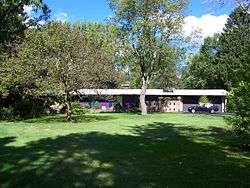
Alcoa Care-free Homes are a group of suburban homes designed for Alcoa (Aluminum Company of America) by Charles M. Goodman during the Mid-century modern movement, incorporating ideas generated at the Women's Congress On Housing. [1] [2]
Contents
While composed of a variety of building materials (brick, steel, wood, and extensive use of glass) they incorporated large amounts (up to 7500 lbs) of aluminum. [3] [4] [5] [6] [7] [8] The homes were introduced in 1957. [9] [10] They were constructed by local contractors using kits provided by Alcoa, [11] and were mostly built in 1958 as model homes. [12] The company had intended to build forty-eight homes, one for each state in union at the time. [13] Eventually, twenty-four were built in sixteen states. [14] [15] The company was sued for misrepresentation of costs to build the homes, with ALCOA claiming costs to build up to $34,000 and selling prices of $50,000 while Associated Contractors Inc., claiming true costs to build the homes were $63,612 with the highest selling price $32,419. [16]